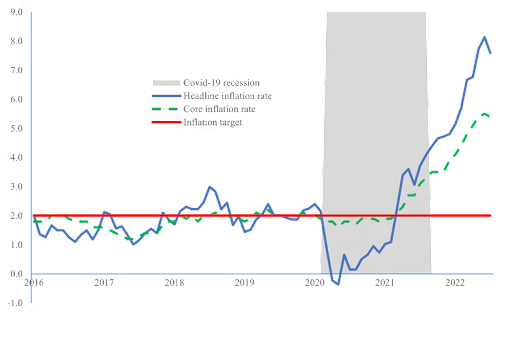Uncategorized
Your Smart Guide to Recession Marketing

- Published: 21/12/2022
- Reading time: 2 minutes
The world, and Canada as part of it, is heading towards a looming recession in 2023. It is thus critical that organizations start adjusting to Recession Marketing. As seen in previous slowdowns, companies will slash marketing budgets, terminate employees and hold off on new demand creation activities. An important question comes to mind: Do businesses need to acquire new clients in times of recession?
Well, if you are not convinced yet that the answer is YES, let’s review the consequences of cutting back on marketing expenditures during times of recession.

A comparison of the Bank of Canada’s inflation target and the current core and headline inflation rates. (The Conversation)

The Impact of Marketing Cuts
Based on previous downturns (the 2020 pandemic, the 2008 recession and the Great Depression), history has shown that marketing cuts result in inevitable long-term consequences:
- Decreased Share of Voice — Your company may offer the best innovative solutions, however, it will be very difficult to get new clients if no one is aware of your products/services, and their benefits. This recognition is a consequence of the amount of marketing “noise” you manage to make. The more vocal your company is, the more likely that potential clients will associate your company as the solution to keep in mind. This fighting for a space in the mind of your target audience is a gradual process. If you stop doing it, you lose this share of voice to your competitors.
- Dwindling Pool of Prospects and Missed Opportunities — While it is a known fact that organizations decrease their overall expenditures during a recession time, they do not hold off their entire spending. If your solutions are not visible enough, your company can miss new opportunities and leads. This means that your sales team must work 10 times harder to find new prospects, while other potential clients who are ready to spend may instead be approached by your competitors.

Learning from Past Examples
Not persuaded yet? Let’s take you all the way back to the times of The Great Recession of the late 1920s. Two early-stage cereal companies introduced a ready-to-eat cereal product, competing with a well-established oatmeal company. The Great Recession came, and what did these companies do? One decided to cut back on advertising expenses to decrease their overall expenditure. The other company did the most unpredictable thing! It doubled their advertising budget and increased investments to push their brand to the world. That second company turned out to be Kellogg’s, the world’s leading cereal brand today. Their aggressive marketing efforts and tenacity in pushing their brand awareness to the general public during a recession time raised their profits to an unimaginable level. The other company that restrained its marketing investment was Post.

Kellogg’s recession marketing strategy vs. Post cuts strategy
OK, we know what you’re thinking: this example is from the food industry and a business-consumer (B2C) vendor. Then, can you please guess how a relatively small B2B software company (Salesforce), reached its first one billion US dollars in annual revenue by the 2009 fiscal year (despite the 2008 recession) and became today’s world’s largest enterprise software firm? Yes, you got it right.

What's Your MarketingReadyTM Ranking?

Four Recession Marketing Strategies
So, what can your company do to achieve greater heights in the face of a recession? Based on a study from the Harvard Business Review (HBR), there are four marketing strategies concluded from the Great Depression and the 2008 economic crisis that can still be applied today:

- Manage your marketing investments — This isn’t surprising to anyone: managing marketing investments is a top priority for succeeding in recession marketing. However, the challenge lies in the allocation of these expenditures. It is essential to make data-driven decisions that back up the choice of where to cut or increase spending. At this point, you should audit your marketing state and pinpoint which areas need more attention. This can range from assessing SEO health, the current Key Performance Indicators (KPIs) of your website and/or the efficiency of your existing campaigns. Of course, do not neglect monitoring your competitors’ activities and assess how you compare to them.

-
- Identify available opportunities — This is the prime time to recognize the risky segment(s) that you may lose during a recession and determine the audience that won’t be willing to convert during these risky times. These segments open enormous opportunities for client conversion. For seamless conversion, companies should focus on creating a unique selling proposition so

- Allocate for the long term — It’s normal to reduce the brand advertising budget when sales start decreasing. But time after time, the companies with the greatest persistence and relentlessness in their marketing efforts find themselves in a sustainable state during a recession and have an easy recovery thereafter. Of course, not everyone will be fortunate enough to proceed with aggressive advertising budgets, but the best course of action is to stabilize your brand during periods of volatility. Even cash-poor companies are recommended to allocate a considerable amount of marketing resources to push the brand proposition. These efforts include properly educating your target market, which builds authority and trust. You do not have to stop at your existing audience but continue building a pool of new prospective clients. Your list of prospects will expand, customer acquisition will increase, and you will significantly boost revenue growth. The big question is how can you sustain these marketing efforts? By maintaining a top-of-mind activity. This means you steadily use social media marketing, publish original content, engage business influencers, and invest in public relations to keep your brand image in a positive light. The combination of these strategies will support your endeavours in nurturing your existing clients and new prospects.
- Balance the budget — In times when you are expected to do more with fewer resources, it is most suitable to invest in sophisticated measurement tools that will provide you with real-time feedback about your marketing efforts. There is no room for missed opportunities and you should strive to achieve high returns on your investments. For example, Marketing Technology (MarTech) Automation is your best ally for better productivity. Consider outsourcing certain marketing projects that will get done more quickly and efficiently by external experienced professionals, again doing more with less.
Marketing activities are no longer a luxury. The combination of all marketing efforts raise your share of voice, creates prospective client opportunities, enhances client experience, and increases good word of mouth. Coupled with excellent customer service and overall product/service improvements, organizations can follow recession marketing guidelines and survive the turmoil ahead.
If you are looking for guidelines, support or specific assistance, please do not hesitate to contact us and to speak to one of our experts.
Testimonials
“Ranking our Web site high on search engines results, designing a professional Web site look and developing engaging relevant content for a heavy technology company like us resulted in a dramatic increase in client leads that we receive from our Web site.”
Simon Robin CEO, Hardent
